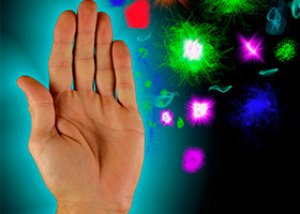
All iLive content is medically reviewed or fact checked to ensure as much factual accuracy as possible.
We have strict sourcing guidelines and only link to reputable media sites, academic research institutions and, whenever possible, medically peer reviewed studies. Note that the numbers in parentheses ([1], [2], etc.) are clickable links to these studies.
If you feel that any of our content is inaccurate, out-of-date, or otherwise questionable, please select it and press Ctrl + Enter.
Immunocytes kill pathogens with the help of "bleach"
Last reviewed: 02.07.2025
 ">
">When attacking a bacterium, the immune system cells – neutrophils – immediately treat it with an oxidizing substance, namely, hypochlorous acid.
The human immune system “knows” many methods of fighting pathogens. One of these methods is the simplest – devouring the enemy.
Neutrophils are most active in this devouring, attacking the infectious agent first. But simply eating the microbe is not enough – it must be reliably destroyed, so neutrophils treat the “swallowed” bacterium with a combination of substances based on a powerful oxidizer. This oxidizer acts as a kind of weapon, which includes hypochlorite, or hypochlorous acid. This substance is known for the fact that bleach is produced from it, also known as bleaching powder, a strong disinfectant and bleach.
This information has been known to specialists for a relatively long time. Scientists also knew what enzyme substances are needed to accumulate the “killer mixture”. But until now it remained a mystery what processes exactly occur in immune cells after the absorption of a microorganism: when the “processing” of the microbe begins, how quickly the bacterium dies, etc. And another question that worried scientists: does a neutrophil die after eating and processing microorganisms after all the processes, or before their completion?
In order to get answers to all the questions posed, specialists representing the Ruhr and Bonn Universities conducted an interesting experiment. They launched a special fluorescent protein into the experimental microorganisms, which is sensitive to oxidation processes. When in an adequate state, the protein was green (after illumination with blue backlight). After the oxidizing effect, in order to acquire a green color, the protein should be illuminated not with blue, but with violet backlight.
Microbes were fed to neutrophils and the events were observed. It was noted that just a couple of seconds after the microbes entered the immune cells, the luminescent protein changed. To put it more simply, neutrophils treated microbes with a damaging substance almost immediately after ingestion. In their work, the scientists noted that, judging by the speed of the process and the degree of oxidation of the fluorescent protein, the main oxidizer was hypochlorite, the so-called precursor of the famous "bleach."
Another necessary component for damaging microbes, in addition to hypochlorite, was hydrogen peroxide. But for a complete damaging effect, only a combination of components was necessary, since each substance separately did not cause the death of the bacteria.
The information published by the scientists allows us to understand how the immune system fights microbial invasion, and for what reasons some microbes remain alive even after an attack by neutrophils.
Details of the study are described in the article https://elifesciences.org/articles/32288
